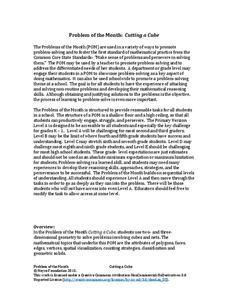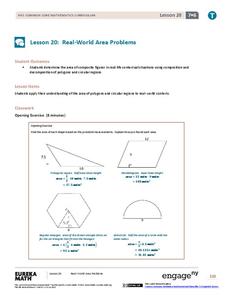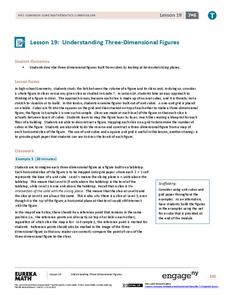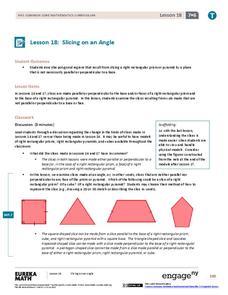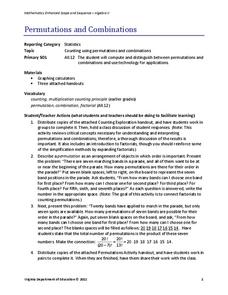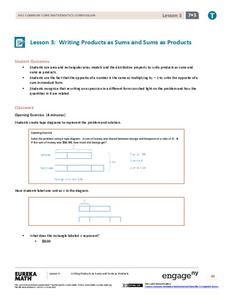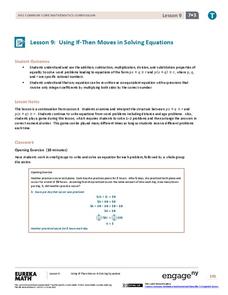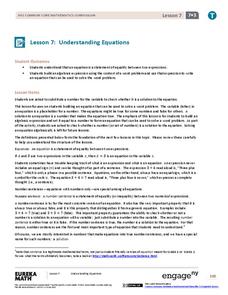Noyce Foundation
Cutting a Cube
Teach the ins and outs of the cube! A series of five K–12 level activities explore the make-up of the cube. The beginning lessons focus on the vocabulary related to the cube. Later lessons explore the possible nets that describe a cube....
Noyce Foundation
Cut It Out
Explore the mathematics of the paper snowflake! During the five lessons progressing in complexity from K through 12, pupils use spatial geometry to make predictions. Scholars consider a folded piece of paper with shapes cut out....
EngageNY
Surface Area II
Examine the surface area of composite figures using an exploratory approach. As a continuation of the previous lesson plan of the 29-part series, young scholars develop plans for finding the surface area of composite figures. Examples...
EngageNY
Real-World Area Problems
Not all structures take the shape of a polygon. The 21st lesson in a series of 29 shows young mathematicians they can create polygons out of composite shapes. Once they deconstruct the structures, they find the area of the composite figure.
EngageNY
Understanding Three-Dimensional Figures
You can't judge a book by its cover ... or a cube structure by just one face. A creative lesson looks at the shape of several cube structures described by level slices. The 20th lesson of the 29-part series expects young mathematicians...
EngageNY
Slicing on an Angle
No matter how you slice it, it's still a polygon! An engaging lesson examines the different ways you can slice a prism. The lesson begins with simple parallel and perpendicular slices. It then challenges scholars to slice the prism to...
EngageNY
Slicing a Rectangular Prism with a Plane
What do you get when you slice a prism? Pupils discover that the answer depends on how the prism is sliced. The second half of the 29-part module focuses on three-dimensional objects. Learners use their two-dimensional vocabulary and...
EngageNY
Checking for Identical Triangles II
Given a diagram of connected or overlapping triangles, individuals must find congruent parts using various properties. Pictures include reflexive sides and vertical angles amongst the marked congruent parts.
EngageNY
Conditions on Measurements That Determine a Triangle
Can any three side lengths create a triangle? Your classes tackle this question and more in the 11th instructional activity of the 29-part module. Through modeling with patty paper, individuals discover the relationship between the...
EngageNY
Population Problems
Find the percent of the population that meets the criteria. The 17th segment of a 20-part unit presents problems that involve percents of a population. Pupils use tape diagrams to create equations to find the percents of subgroups...
EngageNY
Unknown Area Problems on the Coordinate Plane
Scholars determine distances on the coordinate plane to find areas. The instructional activity begins with a proof of the formula for the area of a parallelogram using the coordinate plane. Pupils use the coordinate plane to determine...
EngageNY
The Area of a Circle
Introduce learners to two methods to estimate the formula for the area of a circle. The first method uses a sector of a circle to form a rectangle, and the other uses grids to estimate the area. The problems in the 18th segment of a...
Virginia Department of Education
Permutations and Combinations
Counting is not all it adds up to be — sometimes it involves multiplying. The lesson introduces permutations and combinations as ways of counting, depending upon whether order is important. Pupils learn about factorials and the formulas...
EngageNY
Solving for Unknown Angles Using Equations II
The third activity in the series of 29 asks learners to identify types of angles to verify angle relationships. They find unknown measures using vertical, adjacent, complementary, supplementary, and 360-degree angles.
EngageNY
Solving for Unknown Angles Using Equations
They say a picture is worth a thousand words—and your pupils may agree after this instructional activity! They read a geometric description and create a diagram from that description. Their diagrams help them find unknown measures based...
EngageNY
Graphing Solutions to Inequalities
Activate the strengths of your visual learners using an informative instructional activity. In the 15th installment of the series of 28, pupils graph their solutions on number lines to create a visual representation of solutions....
EngageNY
Inequalities
The 13th activity in the 28-part module asks scholars to write linear inequalities from a problem situation. Individuals then solve and interpret their results in the context of the problem.
EngageNY
Writing Products as Sums and Sums as Products
Create rectangle and area models to help students understand expressions. The third installment in the 28-part series has pupils first represent expressions using rectangular array models. The exercises help scholars understand the...
EngageNY
Generating Equivalent Expressions
Pupils develop expressions to describe the total number of sides on an unknown number of rectangles and triangles. Expressions contain multiplication, addition, and parentheses.
Virginia Department of Education
Simplifying Square Roots of Whole Numbers
Simplify your life by using a resource on simplifying square roots. Pupils review square roots and calculate values of given radical expressions using a calculator. The lesson concludes by having them consider the results to develop the...
EngageNY
Solving for Unknown Angles Using Equations III
Challenge your classes to combine geometric and algebraic concepts with an activity that builds on concepts learned in the first three lessons of the series. The fourth part asks scholars to identify geometric angle relationships and use...
EngageNY
Using If-Then Moves in Solving Equations II
Continuing from the previous lesson in the 28-part series, learners write equations to model problem situations. They then solve the problem by applying the properties of equality. In contrast to the previous lesson, they do not write...
EngageNY
Understanding Equations
After examining expressions in the first six lessons of the series, learners are now ready to apply those concepts to create equations in the seventh installment of 28. Each exercise contains a conceptual situation that helps build an...
EngageNY
Writing Products as Sums and Sums as Products II
Explain algebraic relationships through an understanding of area and perimeter. Continuing concepts built in the third instructional activity of the series, the fourth installment of 28 asks learners to identify common expressions...
